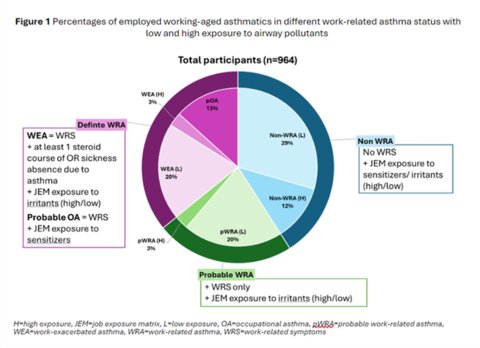HANDS-ON ASTHMA (Health and Social Factors and their influence on asthma symptoms at work): Α cross-sectional study
27 Mar 2025
Introduction: Around 1 in 4 working-aged asthmatics suffer from work-exacerbated asthma (WEA), leading to poor health and employment outcomes. Work-related symptoms (WRS) can be triggered by conditions at work like inhaled irritants, extreme temperatures, and emotional stress. However, some asthmatics report worsened symptoms even working in low-risk environments. We aimed to describe associations between bio-psychosocial and workplace cultural factors and the presence of WEA.
Methods: We invited employed working-aged asthmatics from 27 English GP practices (n=763), NIHR Be-Part-of-Research Scheme (n=789) and other workplaces (n=62) between March 2023-March 2024. Data were collected by questionnaire including items on demographics, asthma control and treatment, employment characteristics, work exposures, WRS, Brief-illness perception questionnaire, EQ-5D, Hospital-anxiety-and-depression scale, absenteeism, Stanford presenteeism scale, and Minnesota satisfaction questionnaire. Occupations were mapped to ISCO-88 and OAs-JEM (job exposure matrix) to determine exposure to inhaled pollutants. WEA defined as having work-related symptoms with ≥1 steroid course or ≥1 absenteeism in last 12 months. Logistic regression was used to examine relationships between relevant variables and diagnoses in different settings.
Results: 964 participants (7.2% response rate) completed questionnaires (Figure1). WEA prevalence=23%. Within people having WRS, those with a regular work pattern were less likely to have high exposure to pollutants (aOR=0.18; 95%CI 0.12-0.27) when adjusted for age, sex, ethnicity, comorbidity, smoking, physical activity, and deprivation score. In low exposure settings, WEA was associated with having depression (aOR=2.57; 1.36-4.85), anxiety (aOR=1.61; 1.02-2.53), poor illness perception score (aOR=1.06; 1.04-1.08), lower job satisfaction score (aOR=0.96; 0.95-0.98), and lower quality of life index (aOR=0.07; 0.02-0.22), compared with those without disease.
Conclusion: Work exacerbated asthma is common in the general population of asthmatics. Shift workers tend to be exposed to higher levels of inhaled pollutants. Where exposure is low, WEA is related to several psycho-social and workplace factors; further qualitative enquiry would help explain these relationships.

Resource information
Respiratory conditions
- Asthma
Type of resource
Abstract Conference
Brasov 2025